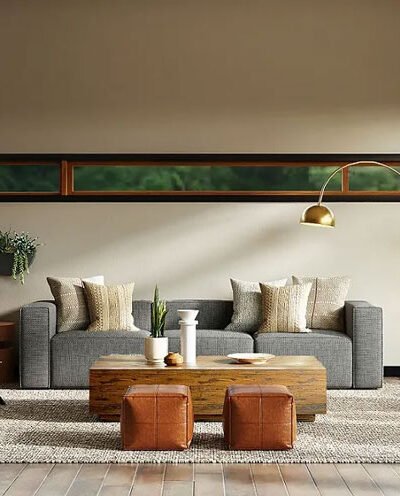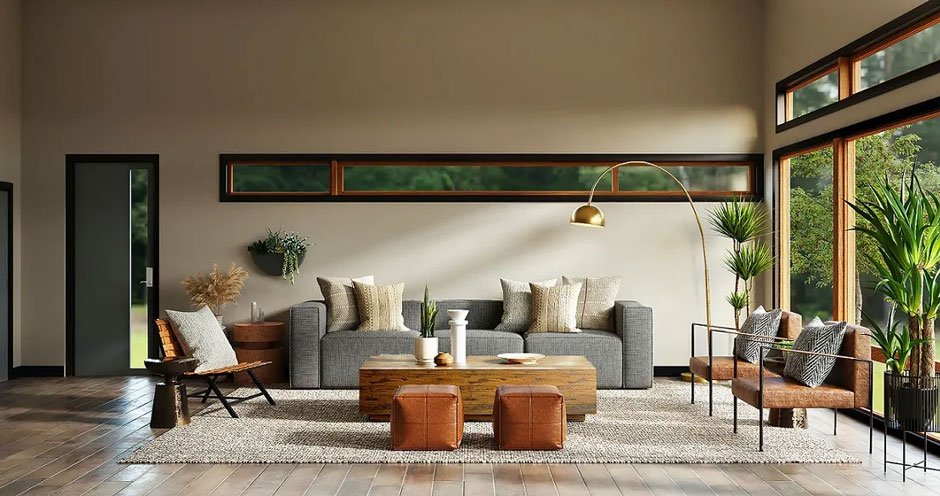From balanced color schemes to thoughtful outdoor enhancements, each element contributes to a harmonious design. Here are inspiring tips to make your home truly stand out.
Choosing the Right Color Scheme
Color sets the tone for any room. Begin by selecting a color palette that aligns with the purpose of your space. For instance, cool tones like blues and grays promote calmness and are perfect for bedrooms or studies. On the other hand, warmer tones such as yellows and terracotta create a more energetic vibe, ideal for living areas and kitchens.
Don’t overlook the power of an accent wall. A single bold color or a tastefully patterned wallpaper can add depth and visual excitement without overwhelming the space. Make sure your furniture and décor complement your chosen palette for a cohesive look.
Arranging Furniture for Functionality and Flow
A room’s layout is just as important as its design elements. A well-arranged furniture layout improves flow and functionality while contributing to visual appeal. Consider the following when arranging furniture in any given room:
- Focus on focal points like a fireplace, television, or a large window. Arrange seating and décor around this central feature.
- Leave enough space for movement between pieces of furniture. Crowded rooms not only feel cramped but can also disrupt the overall aesthetic.
- Use rugs to define different areas, especially in open floor plans. For example, place a rug under the coffee table to visually anchor the seating area.
Minimalist arrangements often create the most elegant spaces, so resist the urge to overcrowd a room with furniture or accessories.
Lighting as the Ultimate Mood-Setter
Lighting is an essential yet often overlooked design element. It can dramatically change how a space feels and looks. To optimize lighting in your home:
- Incorporate layers of light, such as ambient (general lighting), task (focused light for specific activities), and accent (decorative lighting) sources.
- Use dimmer switches to adjust lighting based on different times of the day or moods.
- Natural light plays a critical role, too. Maximize sunlight by using sheer curtains or arranging mirrors to reflect light around the room.
Statement lighting fixtures, like modern chandeliers or pendant lights, can serve as both functional elements and striking design pieces.
Adding Visual Interest Through Textures
Texture is an underrated tool in interior design. A mix of different materials can make a room feel dynamic and layered. Try adding soft textiles like throw blankets and cushions, alongside harder materials like metal, wood, or glass.
You can also achieve texture with wall treatments such as textured paint or panels. Even a rug, whether plush or woven, contributes significantly to creating a rich and inviting ambiance. Don’t forget to blend elements—the contrast between smooth and rough surfaces often leads to the most pleasing aesthetic.
Outdoor Spaces and Curb Appeal
The home’s exterior is often the first impression visitors have, making it as important as the interior. While landscaping is a significant component of curb appeal, the structure itself shouldn’t be neglected. A fresh coat of paint on your main door, a revamped porch area, or even updated residential garage doors in St.George can transform the look of your home’s exterior.
Enhance outdoor spaces by incorporating comfortable seating areas, cozy lighting for evenings, and some vibrant planters. These elements extend your interior aesthetic to the exterior, creating a seamless indoor-outdoor connection.
Personal Touches and Décor
While sticking to a cohesive theme is important, your home should feel uniquely yours. Personalize spaces with curated art pieces, family photo displays, or collectibles that reflect your interests and history.
When it comes to décor, less is often more. Aim for a balance where each piece contributes to the room’s character without crowding the space. Wall art, vases, and sculptures can add personality and elevate the overall look.
Plants and greenery also breathe life into a home. Whether it’s a small potted succulent or a large fiddle leaf fig, plants offer both aesthetic charm and improved air quality.
Key Takeaways for an Inspiring Home
To create a captivating home, every detail matters. Start with an intentional color scheme that reflects the nature of each space. Arrange furniture to balance functionality and aesthetic appeal, ensuring the design promotes flow and comfort. Lighting plays a big role in setting the mood, so layer various light sources and maximize natural light where possible.
Don’t forget to incorporate texture for a rich and balanced design. Address outdoor areas to establish a strong first impression, keeping the overall look consistent with your home’s interior. Lastly, personalize your home with unique décor and accents to make it a true reflection of who you are. With these tips, your home can achieve the perfect mix of style and warmth, creating a space that’s as inviting as it is beautiful.






Leave a Reply